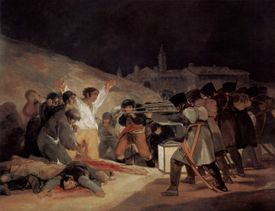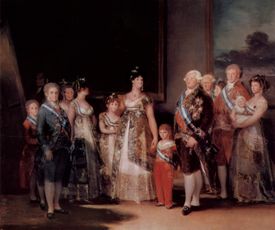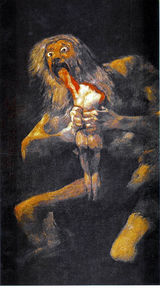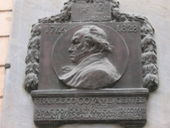Francisco Goya
2007 Schools Wikipedia Selection. Related subjects: Artists
Francisco José de Goya y Lucientes ( March 30, 1746 – April 16, 1828) was a Spanish painter and printmaker.
Goya was a portraitist and court painter to the Spanish Crown, a chronicler of history, and, in his unofficial work, a revolutionary and a visionary. He has been regarded both as the last of the old masters and as the first of the moderns. The subversive and subjective element in his art, as well as his bold handling of paint, provided a model for the work of later generations of artists, notably Manet and Picasso.
Many of Goya's works are on display at the Museo del Prado in Madrid.
Biography
Goya was born in Fuendetodos, Spain in the province of Aragon in 1746 to Joseph Goya and Gracia Lucientes. He spent his childhood in Fuendetodos, where his family lived in a house bearing the family crest of his mother, and which was surrounded by the dry lands. His father earned his living as a guilder. About 1749, the family bought a house in the city of Zaragosa and some years later moved into it.
Goya attended school at Escuelas Pias, where he formed a close friendship with Martin Zapater, and their correspondence over the years became valuable material for biographies of Goya. At age 14, he entered apprenticeship with the painter Jose Lujan.
He later moved to Madrid where he studied with Anton Raphael Mengs, a painter who was popular with Spanish royalty. He clashed with his master, and his examinations were unsatisfactory.
Goya submitted entries for the Spanish Royal Academy in 1763 and 1766, but was denied entrance. He then journeyed to Rome, where in 1771 he won second prize in a painting competition organized by the City of Parma.
He returned to Saragossa in 1771 and painted a part of the cupola of the Basilica of the Pillar, frescoes of the oratory of the cloisters of Aula Dei, and the frescoes of the Sobradiel Palace. He studied with Francisco Bayeu y Subías and his painting began to show signs of the delicate tonalities for which he became known.
Goya and Bayeu's sister, Josefa, married in 1774. His marriage to Josefa (he called her Pepa) helped him to procure work with the Royal Tapestry Workshop, where over the course of five years he designed some 42 patterns. He also gained access to the royal court, painted a canvas for the altar of the Church of San Francisco El Grande, and was appointed a member of the Academy of San Fernando.
In 1783, the Count of Floridablanca, a favourite of King Carlos III, commissioned him to paint his portrait. He also became friends with Crown Prince Don Luis, and lived in his house. His circle of patrons grew to include the Duke and Duchess of Osuna, whom he painted, the King and other notable people of the kingdom.
After the death of Carlos III in 1788 and revolution in France in 1789, during the reign of Carlos IV, Goya reached his peak of popularity with royalty.
After contracting a high fever in 1792 Goya was left deaf, and he became withdrawn and introspective. During the five years he spent recuperating, he read a great deal about the French Revolution and its philosophy. The bitter series of aquatinted etchings that resulted were published in 1799 under the title Los Caprichos. The dark visions depicted in these prints are partly explained by his caption, "The sleep of reason produces monsters" (alternate translation: "The dreams of reason produce monsters"). Yet these are not solely bleak in nature and demonstrate the artist's sharp satirical wit, particularly evident in etchings such as Hunting for Teeth. Additionally, one can discern a thread of the macabre running through Goya's work, even in his earlier tapestry cartoons.
In 1799 he was appointed the Spanish royal painter with a salary of 50,000 reales and 500 ducats for a coach. He worked on the cupola of the Hermitage of San Antonio de la Florida; he painted the King and the Queen, royal family pictures, portraits of the Prince of the Peace and many other nobles.
As French forces invaded Spain during the Peninsular War (1808–1814), the new Spanish court received him as had its predecessors.
When Pepa died in 1812, Goya was painting The Charge of the Mamelukes and The Third of May 1808, and preparing the series of prints known as The Disasters of War.
King Ferdinand VII came back to Spain but relations with Goya were not cordial. In 1814 Goya lived with his cousin Rosario Weiss, and her daughter, Dona Leocadia, whom he loved madly. He continued to work incessantly on portraits, pictures of Santa Justa and Santa Rufina, lithographs, pictures of tauromachy, and more.
With the idea of isolating himself, he bought a house near Manzanares, which was known as the Quinta del Sordo (roughly, "House of the Deaf Man"). There he made the Black Paintings.
Unsettled and discontented, he left Spain in May 1824 for Bordeaux and Paris. He settled in Bordeaux. He returned to Spain in 1826 after another period of ill health. Despite a warm welcome, he returned to Bordeaux where he died in 1828 aged 82.
Works
Goya painted the Spanish royal family, including Charles IV of Spain and Ferdinand VII. His themes range from merry festivals for tapestry, draft cartoons, to scenes of war and corpses. This evolution reflects the darkening of his temper. Modern physicians suspect that the lead in his pigments poisoned him and caused his deafness since 1792. Near the end of his life, he became reclusive and produced frightening and obscure paintings of insanity, madness, and fantasy. The style of these Black Paintings prefigure the expressionist movement. He often painted himself into the foreground.
Two of Goya's best known paintings are The Nude Maja (La Maja desnuda) and The Clothed Maja (La Maja vestida). They depict the same woman in the same pose, naked and clothed respectively. He painted La Maja Vestida after outrage in Spanish society over the previous Desnuda. He refused to paint clothes on her, and instead created a new painting. (See also: Majo.)
In a period of convalescence during 1793–94, he completed a set of eleven small pictures painted on tin, called the pictures of “Fantasy and Invention” that mark a change in his art. These paintings no longer represent the world of popular carnival, but rather a dark, dramatic realm of fantasy and nightmare. "Courtyard with Lunatics" is a horrifying and imaginary vision of loneliness, fear and social alienation, a departure from the rather more superficial treatment of mental illness in the works of earlier artists such as Hogarth. In this painting, the ground, sealed by masonry blocks and iron gate, is occupied by patients and a single warden. The patients are variously staring, sitting, posturing, wrestling, grimacing or disciplining themselves. The top of the picture vanishes with sunlight, emphasizing the nightmarish scene below.
This picture can be read as an indictment of the widespread punitive treatment of the insane, who were confined with criminals, put in iron manacles, and subjected to physical punishment. And this intention is to be taken into consideration since one of the essential goals of the enlightenment was to reform the prisons and asylums, a subject common in the writings of Voltaire and others.
This condemnation of brutality towards prisoners (whether they were criminals or insane) was the subject of many of Goya’s later paintings.
As he completed this painting, Goya was himself undergoing a physical and mental breakdown. It was a few weeks after the French declaration of war on Spain, and Goya’s illness was developing. A contemporary reported, “the noises in his heads and deafness aren’t improving, yet his vision is much better and he is back in control of his balance.” His symptoms may indicate a prolonged viral encephalitis or possibly a series of miniature strokes resulting from high blood pressure and affecting hearing and balance centers in the brain.
In 1799 he created a series of 80 prints titled Los Caprichos depicting what he called "the innumerable foibles and follies to be found in any civilized society, and from the common prejudices and deceitful practices which custom, ignorance, or self-interest have made usual."
In The Third of May, 1808: The Execution of the Defenders of Madrid, Goya attempted to "perpetuate by the means of his brush the most notable and heroic actions of our glorious insurrection against the Tyrant of Europe" The painting does not show an incident that Goya witnessed; rather it was meant as more abstract commentary.
In later life Goya bought a house Quinta del Sordo ("Deaf Man's House") and painted many unusual paintings on canvas and on the walls, including references to witchcraft and war. One of these is the famous work Saturn Devouring His Sons (known informally in some circles as Devoration or Saturn Eats His Child), which displays a Greco-Roman mythological scene of the god Saturn consuming a child, a reference to Spain's ongoing civil conflicts. This painting is one of 14 in a series called the Black Paintings. After his death the wall paintings were transferred to canvas and remain some of the best examples of the later period of Goya's life when, deafened and driven half-mad by what was probably an encephalitis of some kind, decided to free himself from painterly strictures of the time and paint whatever nightmarish visions came to him. Many of these works are in the Prado museum in Madrid.
In the 1810s, Goya created a set of aquatint prints titled Los Desatres de la Guerra (The Disasters of War) which depict scenes from the Peninsular War. The prints were published in 1863, 35 years after his death.
Goya had many friends within the Spanish nobility, and received many orders from them. Some of the most famous paintings were done for Pedro de Álcantara Téllez-Girón, 9th Duke of Osuna and his wife María Josefa de la Soledad, 9th Duchess of Osuna, his famous patron María del Pilar Teresa Cayetana de Silva y Álvarez de Toledo, 13th Duchess of Alba who is almost universally known as the "Duchess of Alba", and her husband José Álvarez de Toledo y Gonzaga, 13th Duke of Alba, and another painting for María Ana de Pontejos y Sandoval, Marchioness of Pontejos.
Cinema and opera
Several films portray Goya's life:
- Goya (1948) at the Internet Movie Database
- Goya, historia de una soledad (1971) at the Internet Movie Database
- Goya in Bordeaux (1999) at the Internet Movie Database
- Volavérunt (1999) at the Internet Movie Database
- Goya's Ghosts (2006) at the Internet Movie Database
Gian Carlo Menotti wrote a biographical opera about him titled Goya (1986), commissioned by Plácido Domingo, who originated the role; this production has been presented on television. He also inspired Michael Nyman's opera Facing Goya (2000), in which he appears in the present to protest the use of his skull in racist science, for which reason the historical Goya had his skull hidden and not buried with the rest of his body.
In 1988 American musical theatre composer Maury Yeston released a studio cast album of his own musical, Goya: A Life In Song. Plácido Domingo again starred as Goya, with Jennifer Rush, Gloria Estefan, Joseph Cerisano, Dionne Warwick, Richie Havens, and Seiko Matsuda singing supporting roles. Music and lyrics were by Yeston, and the recording was released by CBS/Sony (483294-2). The score featured one break-out song, “Till I Loved You,” sung by Placido Domingo and Gloria Estefan. It was subsequently a Top 40 hit by Barbra Streisand. In spite of that commercial success, the piece has not recieved a major staging.





